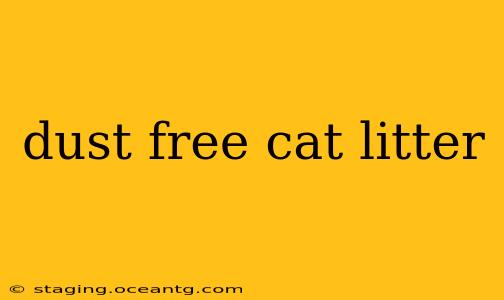Choosing the right cat litter can be a surprisingly complex task. For many cat owners, particularly those with allergies or respiratory sensitivities, finding a truly dust-free cat litter is paramount. This guide will delve into the world of dust-free options, exploring their benefits, drawbacks, and helping you make an informed decision for your feline friend and your household.
What Makes Cat Litter Dusty?
Before we explore dust-free options, it's helpful to understand why some litters are dustier than others. Many traditional clay-based litters are processed in a way that leaves fine particles of clay suspended in the air. These particles, when disturbed during scooping or your cat's use of the litter box, can become airborne, leading to dust clouds. The dust itself is often composed of silica, a known respiratory irritant.
The Benefits of Choosing Dust-Free Cat Litter
The advantages of opting for dust-free litter are significant, especially for sensitive individuals:
- Reduced Allergies and Respiratory Irritation: This is the primary benefit. Dust-free options minimize the airborne particles that trigger allergic reactions or respiratory problems in both cats and humans.
- Cleaner Home Environment: Less dust means less cleaning. Dust-free litter contributes to a cleaner, healthier home environment for everyone.
- Improved Air Quality: By reducing airborne irritants, you improve the overall air quality in your home, promoting better respiratory health.
Different Types of Dust-Free Cat Litter
Several types of cat litter claim to be dust-free or low-dust. Let's examine the most common:
- Silica Gel Litter: Known for its superior absorbency and odor control, silica gel litter is often touted as dust-free. It's made of small, crystal-like granules that don't easily crumble into dust.
- Wood Pellet Litter: Made from compressed wood, this option is a naturally biodegradable and often marketed as dust-free or low-dust. However, some wood litters can create a fine wood dust if not properly processed. Look for those explicitly labeled as low-dust or dust-free.
- Paper Pellet Litter: Similar to wood pellet litter in its biodegradable nature, paper pellet litter is also often touted as a dust-free alternative. It tends to clump less effectively than other options, however.
- Corn-Based Litter: Made from corn cobs, this litter is biodegradable and usually low in dust. However, like wood and paper litters, it is often less effective at clumping.
What to Look for When Buying Dust-Free Cat Litter
Not all "dust-free" litters are created equal. When making your purchase, consider these factors:
- Explicit Labeling: Look for clear labeling indicating that the litter is dust-free or low-dust. Avoid vague terms.
- Reviews: Check online reviews from other cat owners to gauge their experiences with the product's dust levels.
- Ingredients: Pay attention to the ingredients list to ensure it aligns with your cat's needs and any sensitivities you might have.
- Clumping Ability: Consider how well the litter clumps. Good clumping makes scooping easier and helps prevent the spread of dust.
Is Dust-Free Cat Litter More Expensive?
Generally, dust-free litters, especially silica gel, tend to be more expensive than traditional clay-based options. However, the potential health benefits and reduced cleaning time might offset the higher cost for many owners.
How Often Should I Change Dust-Free Cat Litter?
The frequency of litter box changes depends on the type of litter and the number of cats. However, regular scooping and complete litter changes are crucial, regardless of the type, to maintain hygiene and minimize odor. Always consult the manufacturer's instructions for specific recommendations.
Can I Use a Dust-Free Litter Box Liner?
While not essential, using a litter box liner can further minimize dust and make cleaning easier. Choose liners that are compatible with your chosen litter type.
By carefully considering these factors and choosing a litter that meets your needs and your cat’s preferences, you can create a cleaner, healthier environment for everyone in your household. Remember to always monitor your cat's reaction to any new litter and consult your veterinarian if you have any concerns.
